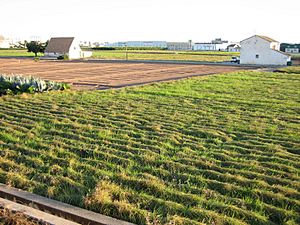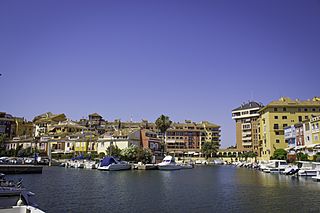Alboraya facts for kids
Quick facts for kids
Alboraya
Alboraia
|
||
|---|---|---|

Chufa cultivation fields in Alboraya
|
||
|
||
| Country | Spain | |
| Autonomous community | Valencian Community | |
| Province | Valencia | |
| Comarca | Horta Nord | |
| Judicial district | Moncada | |
| Area | ||
| • Total | 8.3 km2 (3.2 sq mi) | |
| Elevation | 5 m (16 ft) | |
| Population
(2018)
|
||
| • Total | 24,222 | |
| • Density | 2,918/km2 (7,560/sq mi) | |
| Demonyms | Alborayense, "Chufero/a" | |
| Time zone | UTC+1 (CET) | |
| • Summer (DST) | UTC+2 (CEST) | |
| Postal code |
46120
|
|
| Official language(s) | Spanish, Valencian | |
Alboraya (Spanish: [alβoˈɾaʝa]) or Alboraia (Valencian: [alboˈɾaja]) is a town and municipality in the province of Valencia, Spain. It is located very close to the big city of Valencia.
Alboraya was originally a farming town. In recent years, it has grown a lot. This is because it is now part of the larger metropolitan area around Valencia. It has good transport links, including two stations on the Valencia metro system. These stations are Alboraya-Palmaret and Alboraya-Peris Aragó. The number of people living here has increased from 11,267 in 1986 to about 24,741 in 2020. Many people in Alboraya, about 58.84%, speak Valencian.
In 1994, most people (45.8%) worked in services, like shops or offices. About 33% worked in factories, and 16.7% worked in farming. Only a small number, 3.60%, worked in construction.
After the elections in May 2011, a new leader was chosen. Miguel Chavarria became the mayor. He was the first mayor from the Spanish Socialist Workers' Party (PSOE) since 1999.
Farmers in Alboraya grow crops using special watering systems. A very important crop is the tiger nut (called chufas in Spanish or xufes in Valencian). These tiger nuts are used to make horchata, which is a very popular cool drink.
Contents
What is Alboraya Like?
Location and Surroundings
Alboraya still has many large, green fields where farming takes place. However, these areas are getting smaller as more buildings are built. The town is close to the Mediterranean Sea on its east side.
The municipality of Alboraya is divided into eight smaller areas. These are Calvet, Desamparados, Mar, Masamardá, Masquefa, Miracle, Savoy, and Vera.
Getting Around Alboraya
Alboraya is well-connected to other parts of the Valencia area. You can use Line 3 of the Valencia Metro, which has two stations in Alboraya. There are also buses from the Municipal Transport Company of Valencia (EMT).
The town council also provides a local bus service. This bus connects different parts of Alboraya, like Port Saplaya and Patacona. It runs every day, about once an hour.
Neighboring Towns
Alboraya shares its borders with several other towns. To the northwest is Almàssera. To the north is Meliana. Tavernes Blanques is to the west. The big city of Valencia is to the south. And to the east, you'll find the Mediterranean Sea. All these towns are in the province of Valencia.
Alboraya's Past
Alboraya has a long history. In the 13th century, King James I of Aragon gave land here to a bishop. Later, in 1331, Gilberto Zanoguera became the lord of Alboraya. For a while in the 15th century, the land belonged to the Crown.
The church in Alboraya was built in the 15th century and is named after Santa Maria. There is also a special chapel near the Carraixet ravine. It is dedicated to Our Lady of Desamparados, who is the Virgin of the Helpless. This chapel was first built in 1414.
Farming has always been very important here. The most famous crop is the tiger nut, which is used to make the popular Alboraya horchata.
The number of people living in Alboraya has grown over time. In 1646, there were about 88 houses. By 1922, there were 4,265 people.
People of Alboraya
The population of Alboraya has increased a lot. In 1986, there were 11,267 people. By 2002, this number had grown to 18,656. In 2001, about 58.84% of people said they could speak Valencian. In 2020, the population was 24,741.
| 1900 | 1910 | 1920 | 1930 | 1940 | 1950 | 1960 | 1970 | 1981 | 1991 | 2001 | 2005 | 2008 | 2011 | 2020 |
|---|---|---|---|---|---|---|---|---|---|---|---|---|---|---|
| 4,700 | 4,807 | 5,712 | 6,124 | 6,749 | 6,885 | 8,073 | 9,126 | 10,786 | 11,697 | 18,201 | 20,514 | 22,174 | 22,915 | 24,741 |
Alboraya's Economy
Most of the jobs in Alboraya are in the service sector. This means jobs in shops, hotels, or other services. In 1994, about 45.80% of people worked in this area. Industry, like factories, employed 33% of people. Farming was important for 16.70% of workers. Construction jobs made up 3.60%.
Culture in Alboraya
Buildings and Art
Alboraya still feels like a traditional town in many parts. It has a coastline that is almost four miles long. Along the coast, there are two neighborhoods: Port Saplaya and Patacona.
Port Saplaya has a special marina where you can park a boat right outside your home! It's a colorful place with houses painted in warm orange, blue, and pink colors. Patacona has homes built where an old paper factory used to be. Both areas have great beaches.
Some important buildings in Alboraya include the Parish Church of Our Lady of the Assumption, which was built in the 18th century. There are also several chapels, like the Chapel of the Holy Christ of Souls and the Hermitage of Santa Barbara. Another special place is the Chapel of the Peixets (Miracle of the Fish), located near the Barranco del Carraixet. These places hold important history, sculptures, paintings, and pottery.
Local Food
Alboraya is known for its delicious food, especially traditional Valencian dishes. These include:
- Arròs amb fesols i naps: a pot dish made with rice, beans, and turnips.
- Arròs al forn: rice baked in the oven.
- Rice with spinach.
- Paella amb fetge: paella made with ox-liver.
- Avellanencs: spicy snails.
For desserts, you can try fartons, which are sweet pastries often eaten with horchata. There's also the "Christian cake" called coca escudellà.
See also
 In Spanish: Alboraya para niños
In Spanish: Alboraya para niños




